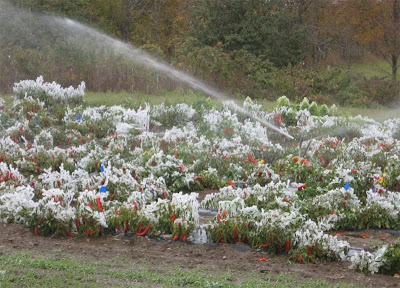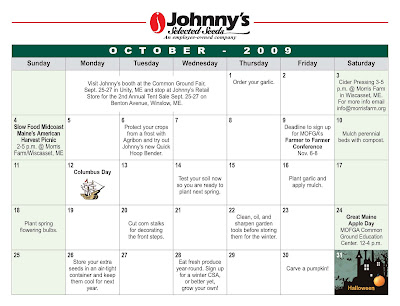The autumnal equinox has passed, the days are quickly getting shorter, and the change of seasons is upon us. It's time to wrap up the current season's unfinished business and start planning for next season.
There's still time to plantIn frost-free climates, you can plant cool-weather crops outside to harvest throughout the fall and winter. These include arugula, beets, broccoli, cabbage, carrots, cauliflower, celery, collards, kale, lettuce, onions, peas, potatoes, radishes, rutabaga, spinach, and turnips. Leafy herbs also do well in winter, so plant chives, cilantro, dill, and parsley.
In mild winter climates, you can plant cool-weather crops under row cover or in the hoophouse to protect them from frost. Their growth won't be as quick as in spring because of the declining day length, but you will be able to harvest many vegetables this fall and winter. Leafy greens and root crops are easy at this time of year. Plant arugula, beets, carrots, collards, kale, lettuce, onions, radishes, spinach, and turnips.
And if you're in a region where hard freezes are common, you can still plant under row cover and overwinter crops that will be ready to harvest early in spring. Onions and spinach will do just fine in most places, given appropriate protection. A hoophouse or Quick Hoops (see Product Spotlight at right) will give you a harvest a month ahead of spring-sown crops next year.
Harvesting the final cropsMany crops will be fine, or even improve, with light frost. Those include most root, leaf, and flower bud vegetables: artichokes, beets, broccoli, Brussels sprouts, cabbage, carrots, cauliflower, chard, collards, kale, lettuce, mustard, onions, parsley, spinach and turnips.
If your markets will be ending soon, you might want to top your Brussels sprouts plants to get a uniform harvest of the sprouts that remain. A week before your expected first frost, cut the growing tip out of each plant. But if you want to keep them producing well into fall, leave them untopped. Their flavor is improved by cold weather and in milder areas, you will be able to pick into December - perfect for holiday markets.plant chives, cilantro, dill, and parsley.
The last of your warm-weather crops may still have harvest potential. Here are some ideas for plants that are likely to still be productive:
Peppers will slow down with the shorter days and cooler temperatures, so pick off any small ones that aren't likely to mature before first frost. The remaining peppers will size up faster. When frost threatens, pull up chile pepper plants and hang them in a warm, well-ventilated area so the chiles will dry.
Winter squash will not ripen after being picked, so you have to protect the entire plant from early frosts if you have a large number of immature fruits. Sprinkler irrigation can be used to protect fruits from light frosts. Mature fruits can withstand one or two light frosts, but too much frost can cause spotting and poor storage.
Tomatoes will ripen and can be labeled "vine-ripened" if they have reached at least the breaker stage - pink on the blossom end - when they are picked. The ripening stages of tomatoes are immature, mature green, breaker, pink, and red. Mature greens are identified by a white to yellow star on the blossom end, and they also may ripen if they are kept dry and above 50°F/10°C. That's the stage when most commercial tomatoes are picked for shipping.
Garden cleanupOnce crops have been harvested, it's time to clean up the remains. Field sanitation consists of plowing down, composting, or otherwise removing plant debris, and mowing adjacent areas. Flowering plants can be left to provide seed for birds, but otherwise plants should be removed from the soil surface to prevent overwintering of pests and diseases. If you had a specific pest problem this season, do some research on the life cycle of the pest to determine where it is overwintering, and take appropriate action to deprive it of those conditions. For example, tarnished plant bugs - a serious pest of strawberries - overwinter as adults in leaf piles and wood piles, so don't leave those near your strawberry field.
Most plant diseases will be killed by hot composting to 160°F/71°C. However, plant pathologists are recommending that plants with late blight be removed from the farm altogether to prevent the inoculum from overwintering.
Weedy areas adjacent to crop fields should be mowed because many kinds of vegetable pests are known to overwinter in them. These include armyworms, cutworms, crickets, earwigs, flea beetles, grasshoppers, lygus bugs, slugs and snails, stink bugs, thrips, and certain viruses vectored by aphids and leafhoppers. (Source: Pests of the Garden and Small Farm by Mary Louise Flint, University of California, available from Growing for Market.)
Reviewing recordsNow is the time for a preliminary records review, while details are still fresh in your mind. In theory, you have been keeping planting and yield information all season, so you can go back and add comments about other aspects of the varieties you grew. Did your customers like it? Did you sell out, or did you have too much? Was the variety quicker or slower to mature than you expected? Was it better or worse than comparable varieties? Write down everything you can think of that will help you decide what to plant, and how much to plant, next year.
You should also have sales records for your crops, so do your tallying soon. When you see how much money you made on a crop - while you're remembering how difficult it was to grow - you'll make better decisions later about whether to grow it again, try a different variety, or drop the crop altogether.
If you sell to wholesale accounts, go back through your invoices and be sure you got paid for everything you delivered. You're more likely to collect an unpaid invoice if you deal with it sooner rather than later.
Finally, try to get at least a ballpark figure of what you earned. You'll have to pay taxes soon, so you need to plan for that final expense of the season.

















